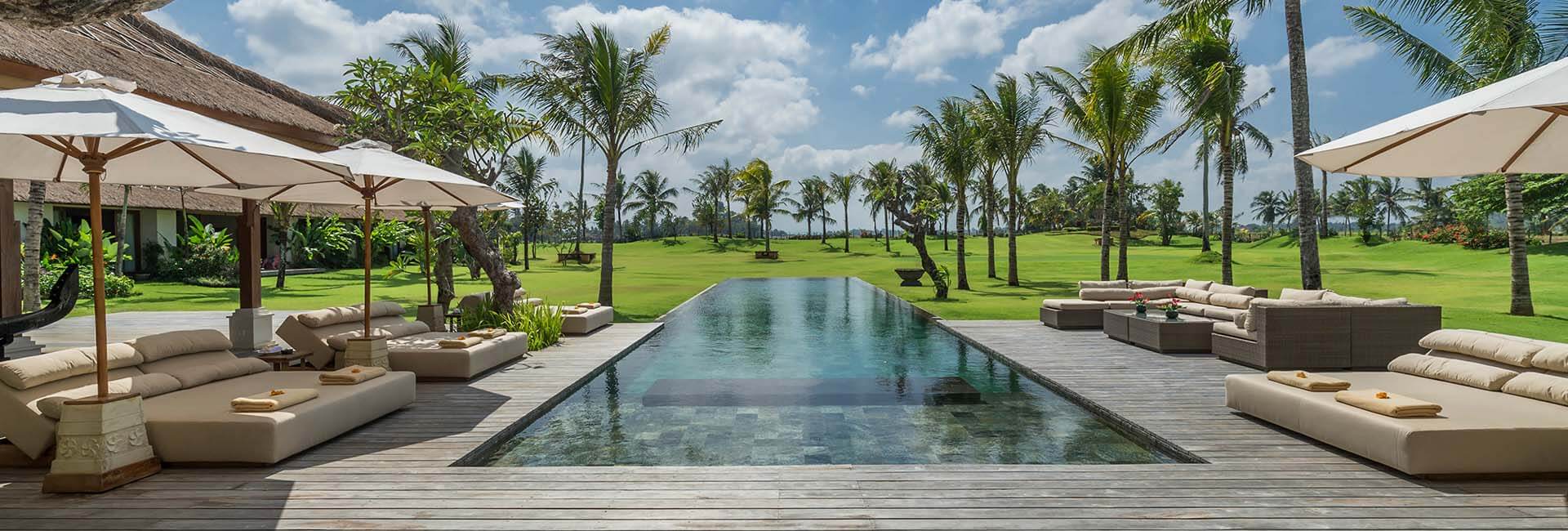Art collection
As well as enjoying the breathtaking natural landscapes that surround this beautiful estate, guests at Kaba Kaba are treated to a private showing of the owners' fascinating art collection, which is displayed throughout the villa's gardens and pavilions. Indonesian and international artists contribute to this exciting and thought-provoking collection. See below for selected works and more information about some of the talented artists.
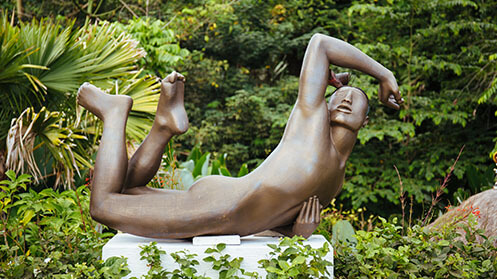
Artist: Cai Zhi Song
Title: Ode to Motherland #5
Year: 2013
Medium: Bronze
Sculpture of a male warrior figure. The artist was inspired by images of ancient China and, in particular, a warrior from the Qin dynasty (221-206 BC). The sculpture was originally made from glass fibre reinforced resin and thin sheets of metal. The owners of the Kaba Kaba Estate commissioned him to create one made of bronze to be placed outdoors. The warrior wears an ornate hairstyle created out of thin wire. This sculpture currently sits in the upper bale bar area.
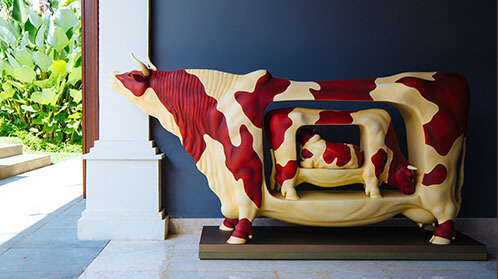
Artist: Agapetus Kristiandana
Title: Tiga Zaman (Three Ages)
Year: 2013
Medium: Resin
Agapetus Agus Kristiandana was born in Yogyakarta, where he still lives, and studied design at Institut Seni Indonesia, Yogyakarta. He has participated in several group exhibitions in Indonesia and abroad, as well as holding solo exhibitions in Jakarta and Central Java. He is known for using animals such as cows and pigs to portray themes of alienation, conflict and dependency, and his works often commnicate through humour and satire.
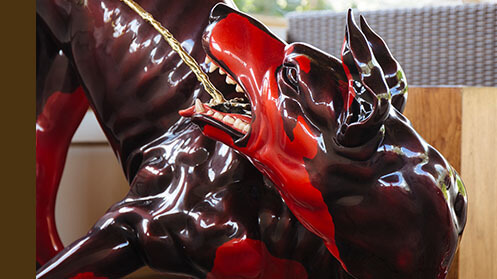
Artist: Agapetus Kristiandana
Title: Binatang Jalang
Year: 2010
Medium: Resin
Agapetus Agus Kristiandana’s paintings combine unexpected elements and create a fresh and surprising narrative about the human condition. His animal sculptures, humorous, and often bizarre in form, stun and invite the viewer to consider his message.
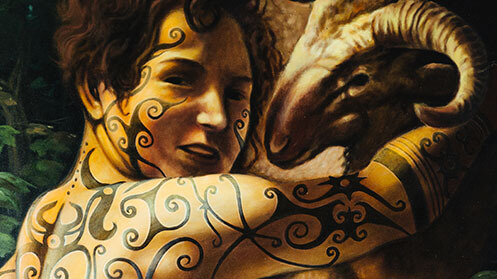
Artist: Dadi Setiyadi
Title: White Goat
Year: 2011
Born in West Java, Dadi Setiyadi graduated from Indonesia Institute of Art in 2004. Dadi’s art revolves around mixed cultural influences, playing with the notions of the east and west, modern and traditional, universal and contextual as well as global and local. White Goat re-imagines Caravaggio’s John the Baptist as a figure with Dayak tattoos.
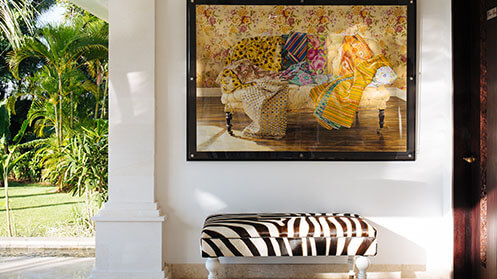
Artist: Hwang Sae Jin
Title: Actual Harmony
Year: 2011
Medium: Acrylics, oils and fabric on canvas
Hwang Sae Jin is a Korean visual artist, born in Seoul in 1982. She graduated from the Painting & Print Department of Ewha Womans University, Seoul, in 2006 and has exhibited in both solo and group shows in Korea. Hwang Sae Jin’s Actual Harmony, a 2011 canvas that unites acrylics, oils, and fabric in an alluring but homey image of a couch, graces Kaba Kaba Estate’s colonial-style guesthouse.
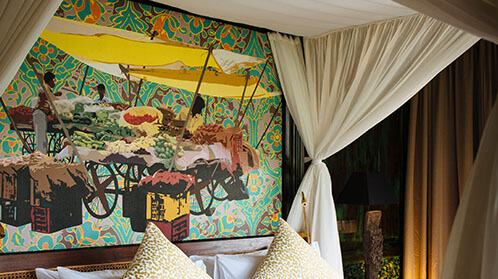
Artist: Sohan Jakhar
Title: Untitled
Year: 2009
Medium: Acrylic
Sohan Jakhar lives and works in Jaipur, Rajasthan. His style of painting is a mix of Indian cultural tradition and pop art, examining the visual dynamics of roadside bazaars which dominate the urban landscapes of India. Photographs are digitally modified and painted on the canvas. The treatment of pictures has a simplistic approach with layers of vibrant colors expressing a subtle theater of visual form.
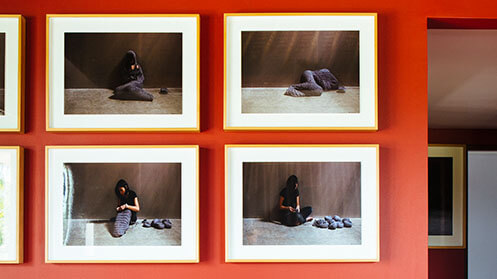
Artist: Bea Camacho
Title: Enclose II
Born in Manila, Philippines, Bea Camacho graduated in Visual and Environmental Studies from Harvard in 2005. She works with sculpture, performance and installation in order to explore issues concerning distance and disconnection in relation to absence and intimacy.The Enclosed II images are taken from a 9-hour performance that was held at the Tate Modern, in which the artist crochets herself into a cocoon.
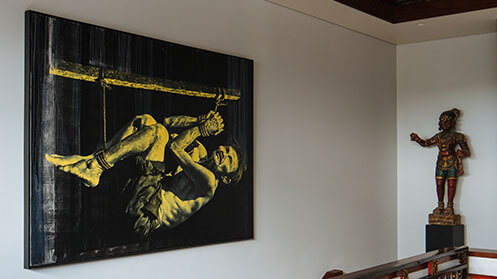
Artist: Mangu Putra
Title: Shackled 1
Year: 2008
Medium: Acrylic on canvas
Mangu Putra articulates his concerns about the disturbing condition of contemporary society; from the exploitation of nature to the devastating impact of pauperisation; from the search for the spiritual in the materialistic world to the place of nationalism in the global era. Environmental issues such as pollution, the killing of animals and global warming are among the main subjects of his paintings.
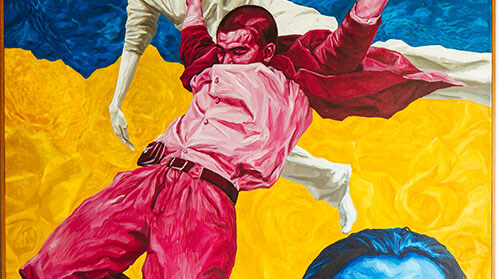
Artist: Ye Zhenghua
Title: The Sky
Medium: Oil on canvas
Three figures painted in monochromatic style – one white, one pink and one blue – appear in The Sky, an oil on canvas by artist Ye Zhenghua. The Chinese artist was awarded the first place prize in the Asia-Europe Young Artists Painting Competition. While The Sky is his only art work at the Kaba Kaba Estate, it is no surprise the piece was chosen – the use of vibrant yellow, blue and pink complement the other works in the collection.
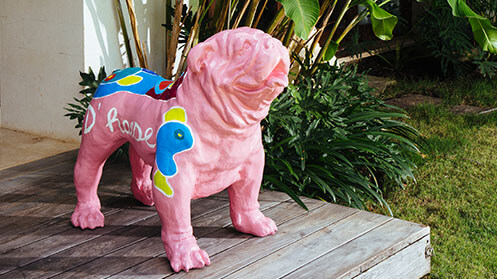
Artist: Hannes D’ haese
Title: Just a dog
Year : 2010
Medium: Resin
Hannes D’haese is the opposite of the classically schooled artist, professing that he has never seen the inside of an art academy. A child of his time, Hannes D’haese is intent on conquering the world. Is he following in the footsteps of Reinhoud d’Haese and Karel Appel (abstract expressionism) or did he redefine love and color into a new form of art? One thing is certain; his art testifies to emotion, passion and happiness.
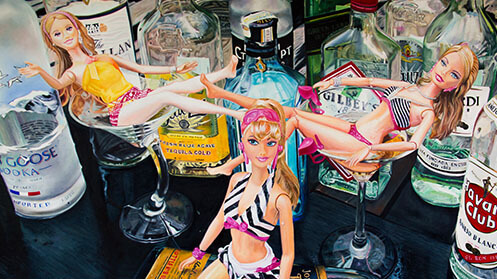
Artist: Dodit Artawan
Title: Pool Party series
Year: 2012
Medium: Acrylic on canvas
Dodit Artawan lives and works in Bali. Upon graduation from the Indonesian Art Institute in Denpasar in 1997, Dodit started his practice as a part of TAXU Art Clinic, an artist collective that created quite a stir in the Balinese art scene. Dodit Artawan’s preferred perspective – viewing scenes from above – places the viewer in a position where they must stand back and observe, and in turn question the “reality” in front of them.
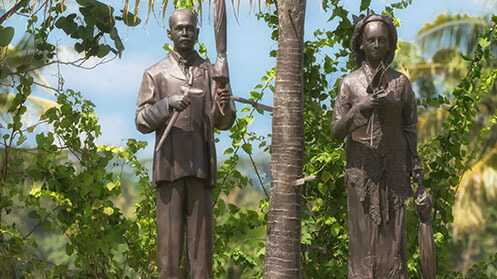
Artist: Entang Wiharso
Title: Borderless floating island
Year: 2013
Medium: Bronze
Entang Wiharso is an internationally renowned artist who has held major exhibitions in Asia, Europe and America. Wiharso’s work emanates from his own personal narratives and experiences. He links minor events and small actions to the larger timeline of the human condition, which he seeks to understand by pushing the boundaries of perceptions formed by prejudices and generalisations.

